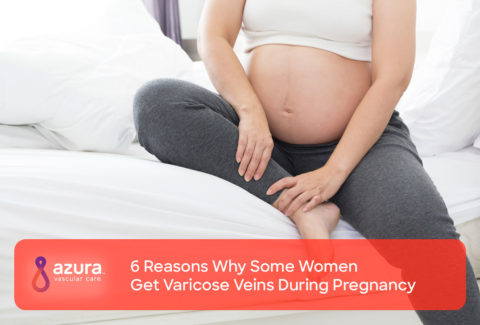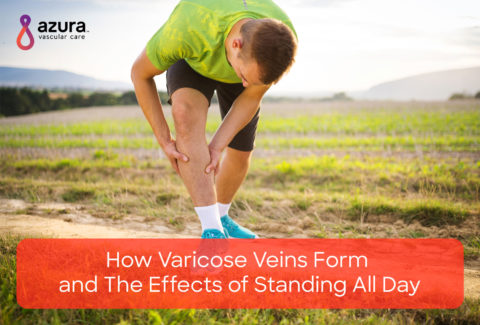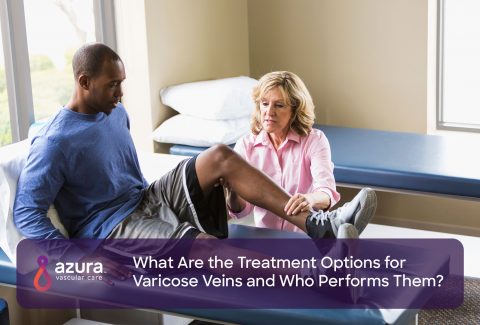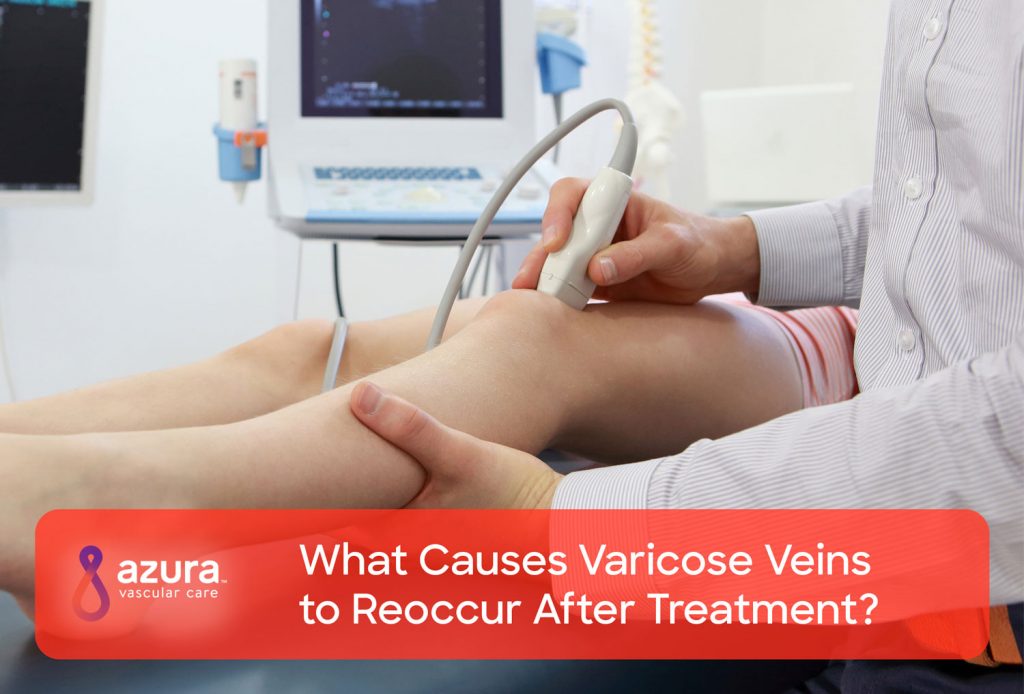
Varicose veins, which can occur in many bodily locations, are caused by malfunctioning valves inside of the veins. These valves are responsible for aiding the transport of blood from your body and extremities back to the heart. One of the most common locations for varicose veins to form are the legs. When these venous valves in the leg don’t work as they should, instead of moving blood back towards the heart, blood may flow backward and pool in the leg veins. This phenomenon is known as venous reflux. (i)
Many patients experience excellent results from surgical procedures to get rid of many varicose veins, but sometimes varicose veins do reoccur. Up to 60 percent of patients may have their varicose veins return after treatment (ii) and this can be frustrating.
Read on to learn more about what causes varicose veins to reoccur and how to choose the most effective treatments.
Potential Causes of Varicose Veins Recurrence
Your Treatment Wasn’t Extensive Enough
Surgical treatments for varicose veins often attempt to cut off blood flow to the malfunctioning vein or veins. Blood flow is naturally redirected to another nearby vein. Once the malfunctioning vein is no longer receiving any blood, it shrinks and disappears. In some procedures, the vein may be “stripped” or removed entirely. (iii)
Sometimes, a single treatment isn’t enough to resolve your problems with venous reflux. Many different veins can experience reflux. Unless all malfunctioning veins are treated, new varicose veins may appear in the future. (iv)
Successful treatment for varicose veins requires planning and preparation. The veins and arteries in your body form a complex system. Your doctor may need to perform imaging tests to examine blood flow throughout your legs. A duplex ultrasound can help your doctor identify all the sources of reflux in the legs. (iv)
If you don’t receive the right tests or if some sources of reflux aren’t treated, new varicose veins may develop after treatment.
Your Condition May be Progressive
Some patients may have a strong genetic predisposition for varicose veins. In some cases, the varicose leg veins may represent the initial phase of venous insufficiency, which may be a chronic or progressive medical condition. If you have a chronic issue with varicose veins, a permanent “cure” may not be possible. (v)
Treatment at a vascular center can help. A vascular specialist can work to develop a treatment strategy that addresses your current symptoms. Proper initial care can also reduce your risk of developing more varicose veins in the future. (vi)
Some patients develop varicose veins as a result of an obstructive disease, like deep-vein thrombosis. These patients may be especially likely to have their varicose veins recur after treatment. (iv) A vascular specialist can help evaluate and treat these disorders, too.
Some Risk Factors Are Still Unresolved
 Even if your original procedure was a success, certain risk factors can increase the risk of recurrence. Obesity and pregnancy can both increase your chances of developing varicose veins in the future. (vi) If you are still overweight or if you become pregnant again after treatment, your varicose veins may come back. A vascular specialist can help you learn to manage these risk factors.
Even if your original procedure was a success, certain risk factors can increase the risk of recurrence. Obesity and pregnancy can both increase your chances of developing varicose veins in the future. (vi) If you are still overweight or if you become pregnant again after treatment, your varicose veins may come back. A vascular specialist can help you learn to manage these risk factors.
New Blood Vessels Have Grown or Healed Since Treatment
After an injury or surgery, your body works to heal itself and create new cells. Sometimes, this healing process can undo the effects of the surgery. Neovascularization, or the development of new blood vessels, is sometimes responsible for the recurrence of varicose veins. (iv)
Treated varicose veins may also recanalize. That means the closed-off veins have opened up and started supporting blood flow again. (iv) Some treatments have a lower risk of neovascularization or recanalization. A vascular specialist can help you review the risks and benefits of each treatment option.
Choosing the Right Varicose Veins Treatment
Treatment for varicose veins is not a one-size-fits-all process. Each patient has individual health needs and risk factors. At a vascular center, you’ll meet with a vascular specialist who will work with you to choose a treatment with the highest chances for success.
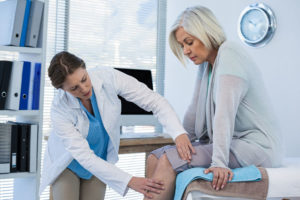 Many patients prefer a minimally invasive procedure. These procedures are performed on an outpatient basis and usually offer a short recovery time. Minimally invasive procedures may include: (iii)
Many patients prefer a minimally invasive procedure. These procedures are performed on an outpatient basis and usually offer a short recovery time. Minimally invasive procedures may include: (iii)
- Laser therapy – strong bursts of light are sent onto the vein, making it fade and disappear.
- Sclerotherapy – an FDA-approved medication is injected into small- and medium-sized varicose veins, which causes them to collapse and fade away.
- Radiofrequency ablation – high-frequency radio waves are used to create thermal energy to cause the varicose vein to collapse and seal shut.
- Phlebectomy or “vein stripping” – this procedure involves removing the vein entirely and is sometimes used in combination with other procedures. Phlebectomy may also be offered as an outpatient treatment. (iii)
For many patients, managing varicose veins requires a long-term strategy. Along with vascular procedures, your specialist may recommend a lifestyle change or at-home treatment such as wearing compression stockings. One single treatment method may not be enough to achieve the results you are seeking. It’s essential to keep working with your specialist to maintain your vascular health and manage all your risk factors.
Choosing the Right Medical Provider
The ideal treatment strategy begins with the ideal medical provider. Choosing a medical provider isn’t always easy. Many clinics claim to treat varicose veins, but not all facilities that treat varicose veins offer the same level of expertise.
The best facilities offer consultations with vascular specialists. Vascular specialists such as interventional radiologists and vascular surgeons know that your varicose veins are only one part of a complex bodily system. Treating your condition requires a full medical evaluation to determine the causes of your varicose veins.
Your vascular specialist will need to consider your medical history, your personal treatment goals, and your current lifestyle. Effective varicose vein treatment may also require extensive imaging tests. A vascular center can provide the comprehensive care you need to finally get rid of stubborn varicose veins.
If you need help managing your varicose vein symptoms or if you are seeking treatment, call 844-832-VEIN (8346) today to schedule an appointment with a vascular specialist.
Sources:
(i) Baliyan, V., Tajmir, S., Hedgire, S. S., Ganguli, S., & Prabhakar, A. M. (2016). Lower extremity venous reflux. Cardiovascular Diagnosis and Therapy, 6(6), 533-543. doi:10.21037/cdt.2016.11.14.
(ii) Saber, A., Hokkam, E., & Gad, M. (2012). Assessment of causes and patterns of recurrent varicose veins after surgery. North American Journal of Medical Sciences, 4(1), 45-48. doi:10.4103/1947-2714.92905.
(iii) Mayo Clinic. (2017, December 28). Varicose veins: Diagnosis & treatment. Retrieved October 4, 2018, from https://www.mayoclinic.org/diseases-conditions/varicose-veins/diagnosis-treatment/drc-20350649.
(iv) Mackay, E. G. (2014). Treatment of recurrent varicose veins. Endovascular Today, 13(7), 65-70.
(v) Alguire, P. & Scovell, S. (2018, May 29). Overview and management of lower extremity chronic venous disease. In K.A. Collins (Ed.), UpToDate. Retrieved October 1, 2018, from https://www.uptodate.com/contents/overview-and-management-of-lower-extremity-chronic-venous-disease?csi=6430313b-0a6d-4266-b271-4024b76c9add&source=contentShare.
(vi) U.S. Department of Health and Human Services. (2018, September 25). Varicose veins and spider veins. Retrieved October 4, 2018, from https://www.womenshealth.gov/a-z-topics/varicose-veins-and-spider-veins.

